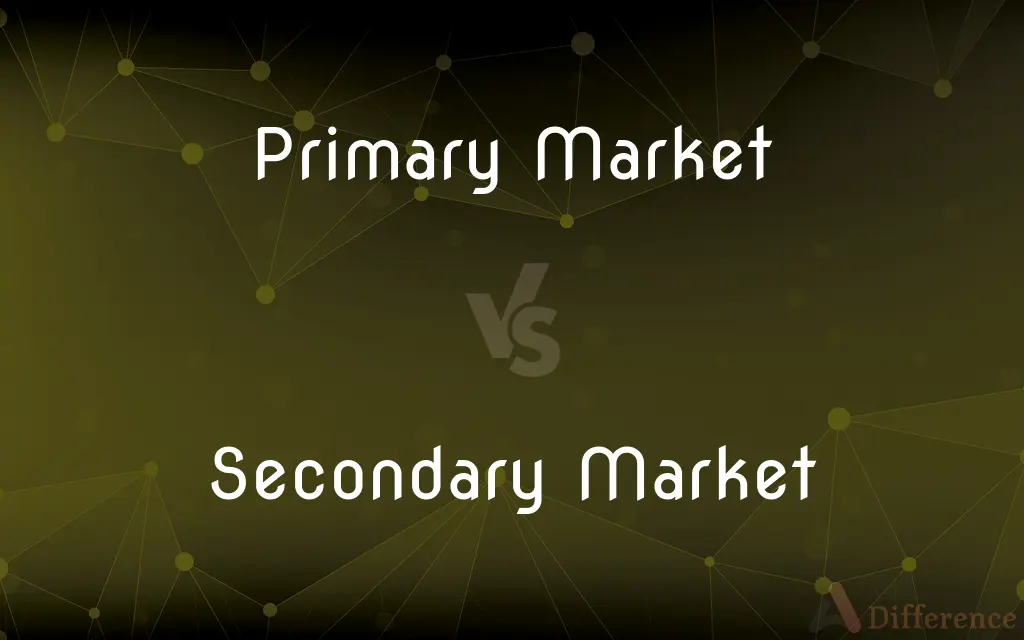Primary Market vs. Secondary Market — What's the Difference?
By Tayyaba Rehman — Published on December 18, 2023
Primary Market is where securities are issued for the first time; Secondary Market is where those securities are traded afterwards.

Difference Between Primary Market and Secondary Market
Table of Contents
ADVERTISEMENT
Key Differences
In the world of finance, the Primary Market and the Secondary Market are two distinct arenas. The Primary Market refers to the platform where securities, often in the form of bonds or stocks, are issued to the public for the first time. It is through this market that companies raise capital by selling new shares or bonds to investors. The Secondary Market, on the other hand, is where these securities are traded after their initial issuance.
The Primary Market is characterized by transactions between the issuing entity and the initial investors. These transactions are facilitated by investment banks, which underwrite the securities, determining their price and volume. The Secondary Market, conversely, involves subsequent trades of these securities among investors themselves, and the issuing company is not directly involved.
Both the Primary Market and the Secondary Market play pivotal roles in the financial ecosystem. The Primary Market provides companies, governments, and other entities the opportunity to raise funds for expansion, projects, or other needs. The Secondary Market, in contrast, provides liquidity for these securities, allowing holders to sell their investments and realize returns.
Another distinguishing factor between the Primary Market and the Secondary Market is the pricing mechanism. In the Primary Market, the price of the security is often set in advance, either through a process known as book building or at a fixed rate. In the Secondary Market, the prices of securities fluctuate based on supply and demand dynamics.
While both the Primary Market and the Secondary Market are essential, they cater to different needs. The Primary Market is all about issuance and capital raising, while the Secondary Market focuses on trading and liquidity.
ADVERTISEMENT
Comparison Chart
Nature
Platform for new securities issuance.
Platform for trading existing securities.
Participants
Issuing entities and initial investors.
Traders and investors.
Involvement of Issuing Entity
Directly involved in raising capital.
Not directly involved in trades.
Price Determination
Fixed or determined through book building.
Determined by supply and demand.
Purpose
Raising capital.
Providing liquidity.
Compare with Definitions
Primary Market
The segment of the financial market facilitating the issuance of new bonds or stocks.
The government tapped into the Primary Market to issue new treasury bonds.
Secondary Market
The market where securities are traded after their initial issuance.
After a company's IPO, its shares are available for trading in the Secondary Market.
Primary Market
A platform where companies can raise capital by selling securities to initial investors.
Through the Primary Market, startups can secure funding for their ventures.
Secondary Market
A platform that provides liquidity to security holders.
Jane sold her stocks in the Secondary Market when she needed cash.
Primary Market
The market that connects issuing entities directly with the investing public.
Many investors eagerly await new listings in the Primary Market to diversify their portfolios.
Secondary Market
The market that ensures investors can buy or sell their holdings as needed.
The robustness of the Secondary Market ensures that investors can liquidate their assets when necessary.
Primary Market
The arena where the price of new securities is set either in advance or through a book-building process.
In the Primary Market, the price of tech company's IPO was set at $20 per share.
Secondary Market
The segment of the financial market where the prices of securities fluctuate based on supply and demand.
The price of Blue Inc.'s stock soared in the Secondary Market following positive earnings reports.
Primary Market
The market where new securities are issued to the public for the first time.
Acme Corp. raised $50 million in the Primary Market by issuing new shares.
Secondary Market
The arena where trades of previously issued securities occur among investors.
The Secondary Market sees billions of dollars in trades every day.
Common Curiosities
Is the issuing company involved in trades in the Secondary Market?
No, the issuing company is not directly involved in trades in the Secondary Market.
Who are the main participants in the Primary Market?
The main participants in the Primary Market are the issuing entities and the initial investors.
Can I buy shares of a company directly from the Primary Market?
Yes, investors can buy shares directly from the Primary Market during an Initial Public Offering (IPO) or other issuance.
What is the primary purpose of the Primary Market?
The Primary Market's main purpose is to facilitate the issuance of new securities to raise capital.
How is the price determined in the Primary Market?
In the Primary Market, the price is often set in advance, either through book building or at a fixed rate.
How is the Secondary Market different from the Primary Market?
The Secondary Market is for trading existing securities, while the Primary Market is for issuing new securities.
Can I participate in the Primary Market without a broker?
Typically, participation in the Primary Market requires a broker or an intermediary.
What drives price fluctuations in the Secondary Market?
Prices in the Secondary Market fluctuate based on supply and demand dynamics.
Are bonds also issued in the Primary Market?
Yes, both stocks and bonds can be issued in the Primary Market.
How do companies benefit from the Secondary Market?
While companies don't raise new capital in the Secondary Market, a robust Secondary Market can increase a company's reputation and make future Primary Market issuances more successful.
What happens to securities after they are sold in the Primary Market?
After being sold in the Primary Market, securities are listed and traded in the Secondary Market.
Why is the Secondary Market important for investors?
The Secondary Market provides liquidity, allowing investors to buy and sell securities as needed.
Can an individual investor sell shares in the Primary Market?
No, individual investors cannot sell their existing shares in the Primary Market; it's for new issuances.
How do I know if a security is trading in the Primary Market or the Secondary Market?
Securities are issued in the Primary Market, usually via IPOs or direct placements. Once issued, they are traded among investors in the Secondary Market.
Is the Secondary Market exclusive to stocks?
No, the Secondary Market includes trading of stocks, bonds, and other financial instruments.
Share Your Discovery

Previous Comparison
Tides vs. Waves
Next Comparison
Metaphase 1 vs. Metaphase 2Author Spotlight
Written by
Tayyaba RehmanTayyaba Rehman is a distinguished writer, currently serving as a primary contributor to askdifference.com. As a researcher in semantics and etymology, Tayyaba's passion for the complexity of languages and their distinctions has found a perfect home on the platform. Tayyaba delves into the intricacies of language, distinguishing between commonly confused words and phrases, thereby providing clarity for readers worldwide.
















































